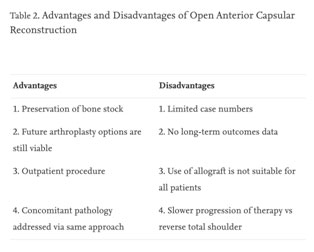Anterior Capsular Reconstruction
Anterior Capsular Reconstruction (Subscapularis Deficiency)

A subscapularis complete tear presents its own challenges in management. The glenohumeral biomechanics and force couple are reliant on a competent and functioning subscapularis muscle. An irreparable subscapularis makes those same challenges even more difficult to address. Traditionally, this problem has been addressed with tendon transfers, including pectoralis major or latissimus dorsi. These techniques can alter the ideal biomechanics of the shoulder and have high rates or failure. Iliotibial autograft or tibialis anterior have also been wrought with high failure rates. Recently, the superior capsular reconstruction has been described for irreparable tears of the supraspinatus and infraspinatus. Theoretically, this procedure can act as a check rein against subluxation, and may serve to reconnect the force couples of the rotator cuff. Anterior escape may represent a similar challenge when the irreparable rotator cuff tendon is the subscapularis. To address this the anterior capsule reconstruction technique with an acellular dermal graft has recently been developed.
Video testimonial after Anterior Capsular Reconstruction a novel technique for revision subscapularis repair.
In patients with irreparable tears of the subscapularis tendon, reconstruction with an allo- or autograft may be a viable therapeutic option. However, the postoperative results of published techniques show varying rates of success. Using a human acellular dermal allograft for an anterior capsule reconstruction (ACR) may offer additional benefits such as superior mechanical strength compared to smaller and thinner tendon allografts used in the past. The implantation of an allograft replaces the torn subscapularis tendon’s role as the anterior joint stabilizer, thus preventing the humeral head from migrating anteriorly by acting as a static restraint. This surgery alters shoulder biomechanics as the graft acts as a static restraint, thereby centering the humeral head during active movement, preventing anterior escape, and thus leading to improved function and pain relief.


















